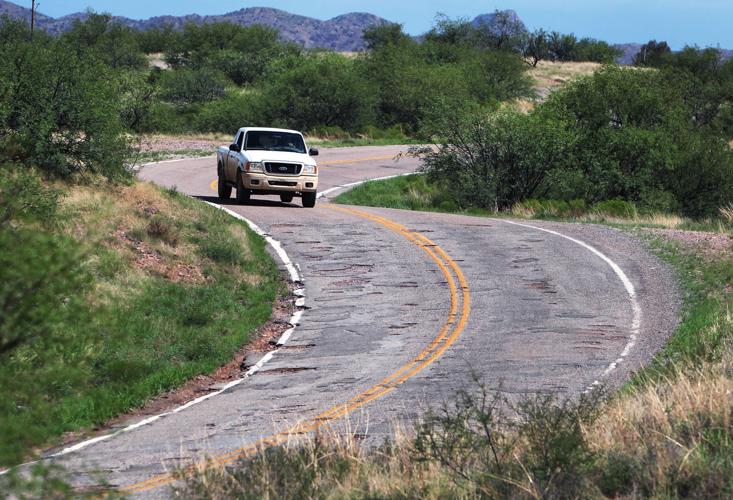Drivers heading south from Arivaca on Ruby Road are greeted with a warning reminiscent of the ominous “I’d turn back if I were you” sign in The Wizard of Oz.
“You are traveling on the most poorly maintained road in Pima County,” is how the hand-painted billboard welcomes drivers to the 5.3 paved miles of roadway that stretches to the county line. It then urges motorists to sign a petition that’s been circulating recently to get the county transportation department to resurface the road, an effort one organizer said has attracted nearly 400 signatures.
There aren’t even 700 people in Arivaca, according to the latest census count.
Some readers are no doubt taking deep breaths in preparation for full-throated disquisitions on why their local roadway is, in fact, the real “most poorly maintained road in Pima County.” The fact of the matter is that there are many roads in poor or failed condition — 60 percent — and Ruby Road is one of them.
On some stretches of the winding roadway, which was last chip-sealed in 1997, avoiding potholes isn’t an option. Rather, drivers must choose which potholes they’d rather hit. Some drivers head to the shoulder for particularly egregious stretches, one resident said.
And even some of the filled-in potholes seem to be hazardous.
“It’s dangerous,” said Gerd Kleinholz, who has to take the road to get between his house and town. “You’re concentrating on the potholes and going on the other side of the road to avoid it, and not paying attention to the traffic.”
Since the chip-sealing almost two decades ago, the county has sunk thousands of dollars into pothole repair, $61,000 alone over the last fiscal year (that works out to $11,400 per mile, which is roughly 10 times the average per-mile rate for other county roads).
Despite its indisputably bad condition, the road is not likely to stack up well against other deteriorating roadways when competing for scarce repair and preservation dollars — just shy of $20 million in fiscal year 2015.
That’s largely due to its extremely low traffic counts. On a Saturday earlier this month, the county transportation department tallied 329 vehicles on the section closest to Arivaca and just 52 on the final stretch that hits the county line.
To redo Ruby Road with new asphalt would cost an estimated $965,000, or $550,000 to do a double chip-seal.
“It’s really difficult balancing,” said County Supervisor Sharon Bronson, who recently met with residents upset about the state of Ruby Road, which is in Bronson’s district. “We’ve got a $350 million road-repair issue. How do you set priorities? We typically look at priorities as urban arterials.”
“Frankly, with the amount of traffic on the road, it’s probably going to be way down on the list,” said John Bernal, deputy county administrator.
That, Bronson said, creates an “equity” issue.
“Rural taxpayers, rural residents deserve the same sort of consideration as we typically give to the urban residents,” she added.
But there’s something else about the road that could open up alternative funding sources and help square the circle: The fact that much, if not most, of the traffic is federal law enforcement agents, mostly with the U.S. Border Patrol.
As it happens, the 2015 federal FAST Act allows border states to set aside a portion of their federal road dollars for border infrastructure projects (specifically, up to 5 percent of annual Surface Transportation Block Grant Program (STBGP) proceeds, Arizona’s share of which will be around $988 million between fiscal years 2016 and 2020).
Bernal said the state is already doing so, mostly for work on state highways with heavy Border Patrol presence, like State Route 286, which ends in Sasabe. However, representatives with the Pima Association of Governments (PAG) told Bernal that it could be possible for local jurisdictions to put in applications for projects like Ruby Road. Bernal added that there could even be enough set aside for the current fiscal year.
“Hopefully we can get our project in the mix,” he said.
But Nathan Barrett, a PAG senior transportation planner, had a few notes of nuance about the use of these funds for projects like Ruby Road. He said the 5 percent is not additional money the state receives, simply a part of regular STBGP funds earmarked for border infrastructure projects.
“That would come out of our allocation that we’re already receiving,” he said. “Also, this would likely not be new funds for the Pima County region, either.”
That’s because the funding would count toward the 13 percent of state-managed roadway funding typically set aside for work in Pima County. In other words, it’s a zero-sum game of sorts, in which prioritizing the Ruby Road project could mean setting others aside.
Whether it’s through the 5 percent set-aside or something else, Bronson would like to see the federal government help pay for repairs.
“Border Patrol is able to benefit at the expense of residents who need the road,” she said.
“We need to have the federal government, they should be a part of the solution ... because they are part of the problem.”
Kleinholz agreed that federal support would be welcome and appropriate, but is more concerned about getting the road paved, and getting it done soon.
“We already waited several years and nothing happened,” he said.
For its part, the Border Patrol said that the road’s condition “has negatively impacted” its vehicle fleet and led to increased maintenance costs. The agency, according to a statement , “does not provide funding for county-maintained roads,” but did suggest the possibility of pursuing a grant from the Department of the Interior.







